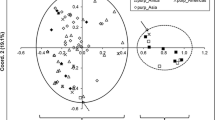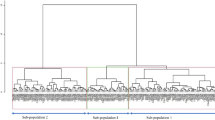Abstract
Population genetic studies are effective ways of researching the origin of, and genetic variation within, crop species, with a view to breeding for increased tolerances or novel traits. This is particularly important now that we are facing climate change and an increasing global population. Lablab purpureus (L.) Sweet (hyacinth bean) is an underutilised legume that has the potential of being an important crop species in the future due to its enhanced environmental tolerances relative to other legumes. It is farmed extensively, but locally, throughout Africa and Asia, however limited research and development of the crop has been undertaken so far, hence an investigation into its origin and diversity is warranted. Our microsatellite analysis suggests an East African origin of Lablab because of the genetic similarities between East African lines and the wild subspecies, subsp. uncinatus. The East African lines were also more genetically diverse. Two chloroplast DNA haplotypes were resolved and Africa was the only continent where both were present, again suggesting an African origin followed by the dissemination of lines outside of Africa coupled with a reduction in genetic diversity. Variation in tolerance to drought was recorded, with some lines able to tolerate 14 days without watering. In sum, we propose an East African origin of Lablab and have identified potential adaptive diversity for future crop breeding attempts.



Similar content being viewed by others
References
Adebisi A, Bosch C (2004) Lablab purpureus (L.) Sweet. In: Grubben G, Denton O (eds) Plant Resources of Tropical Africa (PROTA), no. 2, vegetables. Wageningen, PROTA Foundation, pp 343–348
Asgar MA, Fazilah A, Huda N, Bhat R, Karim AA (2010) Nonmeat protein alternatives as meat extenders and meat analogs. Compr Rev Food Sci Food Saf 9:513–529. doi:10.1111/j.1541-4337.2010.00124.x
Ashley J (1993) Drought and crop adaptation. In: Rowland J (ed) Dryland farming in Africa. MacMillan Press, London, pp 46–67
Blair MW, Diaz JM, Hidalgo R, Diaz LM, Duque MC (2007) Microsatellite characterization of Andean races of common bean (Phaseolus vulgaris L.). Theor Appl Genet 116:29–43
Burke JM, Burger JC, Chapman MA (2007) Crop evolution: from genetics to genomics. Curr Opin Genet Dev 17:525–532
Chapman MA (2015) Transcriptome sequencing and marker development for four underutilized legumes. Appl Plant Sci 3:1400111
Chapman MA, Pashley CH, Wenzler J, Hvala J, Tang S, Knapp SJ, Burke JM (2008) A genomic scan for selection reveals candidates for genes involved in the evolution of cultivated sunflower (Helianthus annuus). Plant Cell 20:2931–2945
Chapman MA, Hvala J, Strever J, Burke JM (2010) Population genetic analysis of safflower (Carthamus tinctorius; Asteraceae) reveals a Near Eastern origin and five centers of diversity. Am J Bot 97:831–840. doi:10.3732/ajb.0900137
Doyle JJ, Doyle JL (1990) Isolation of plant DNA from fresh tissue. Focus 12:13–15
Earl DA, von Holdt BM (2012) STRUCTURE HARVESTER: a website and program for visualizing STRUCTURE output and implementing the Evanno method. Conserv Genet Resour 4:359–361
Evanno G, Regnaut S, Goudet J (2005) Detecting the number of clusters of individuals using the software STRUCTURE: a simulation study. Mol Ecol 14:2611–2620
Ewansiha SU, Singh BB (2006) Relative drought tolerance of important herbaceous legumes and cereals in the moist and semi-arid regions of West Africa. J Food Agric Environ 4:188–190
Fuller D (2003) African crops in prehistoric South Asia: a critical review. In: Neumann K, Butler A, Kahlheber S (eds) Foods, fuels, fields—progress in African archaeobotany. Heinrich-Barth Institut, Köln, pp 239–271
Harter AV, Gardner KA, Falush D, Lentz DL, Bye RA, Rieseberg LH (2004) Origin of extant domesticated sunflowers in eastern North America. Nature 430:201–205
Hinze LL, Fang DD, Gore MA, Scheffler BE, Yu JZ, Frelichowski J, Percy RG (2015) Molecular characterization of the Gossypium diversity reference set of the US National Cotton Germplasm Collection. Theor Appl Genet 128:313–327. doi:10.1007/s00122-014-2431-7
Kalinowski ST, Taper ML, Marshall TC (2007) Revising how the computer program CERVUS accommodates genotyping error increases success in paternity assignment. Mol Ecol 16:1099–1106. doi:10.1111/j.1365-294X.2007.03089.x
Karachi M (1997) Growth and nutritive value of Lablab purpureus accessions in semi-arid Kenya. Trop Grassl 31:214–218
Kimani E, Wachira F, Kinyua M (2012) Molecular diversity of Kenyan lablab bean (Lablab purpureus (L.) Sweet) accessions using amplified fragment length polymorphism markers. Am J Plant Sci 3:313–321
Lasry Benchimol L et al (2007) Structure of genetic diversity among common bean (Phaseolus vulgaris L.) varieties of Mesoamerican and Andean origins using new developed microsatellite markers. Genet Resour Crop Evol 54:1747–1762. doi:10.1007/s10722-006-9184-3
Maass BL, Usongo MF (2007) Changes in seed characteristics during the domestication of the lablab bean (Lablab purpureus (L.) Sweet: Papilionoideae). Aust J Agric Res 58:9–19. doi:10.1071/ar05059
Maass BL, Jamnadass RH, Hanson J, Pengelly BC (2005) Determining sources of diversity in cultivated and wild Lablab purpureus related to provenance of germplasm by using amplified fragment length polymorphism. Genet Resour Crop Evol 52:683–695. doi:10.1007/s10722-003-6019-3
Maass B, Knox M, Venkatesha S, Angessa T, Ramme S, Pengelly B (2010) Lablab purpureus —a crop lost for Africa? Trop Plant Biol 3:123–135
McDonald LM, Wright P, MacLeod DA (2001) Nitrogen fixation by lablab (Lablab purpureus) and lucerne (Medicago sativa) rotation crops in an irrigated cotton farming system. Aust J Exp Agric 41:219–225. doi:10.1071/ea99143
Mondini L, Noorani A, Pagnotta M (2009) Assessing plant genetic diversity by molecular tools. Diversity 1:19–35
Murphy A, Colucci P (1999) A tropical forage solution to poor quality ruminant diets: a review of Lablab purpureus. Livestock Research for Rural Development (FAO) 11. http://www.fao.org/livestock/agap/frg/lrrd/lrrd11/12/colu112.htm
Peakall R, Smouse PE (2006) GENALEX 6: genetic analysis in Excel. Population genetic software for teaching and research. Mol Ecol Notes 6:288–295
Pengelly BC, Maass BL (2001) Lablab purpureus (L.) Sweet—diversity, potential use and determination of a core collection of this multi-purpose tropical legume. Genet Resour Crop Evol 48:261–272. doi:10.1023/a:1011286111384
Pritchard JK, Stephens M, Donnelly P (2000) Inference of population structure using multilocus genotype data. Genetics 155:945–959
Rai N, Singh PK, Rai AC, Rai VP, Singh M (2011) Genetic diversity in Indian bean (Lablab purpureus) germplasm based on morphological traits and RAPD markers. Indian J Agric Sci 81:801–806
Rauscher G, Simko I (2013) Development of genomic SSR markers for fingerprinting lettuce (Lactuca sativa L.) cultivars and mapping genes. BMC Plant Biol. doi:10.1186/1471-2229-13-11
Schaaffhausen R (1963) Dolichos lablab or hyacinth bean: its uses for feed, food and soil improvement. Econ Bot 17:146–153
Schuelke M (2000) An economic method for the fluorescent labeling of PCR fragments. Nat Biotechnol 18:233–234
Shivachi A, Kiplagat K, Kinyua G (2012) Microsatellite analysis of selected Lablab purpureus genotypes in Kenya. Rwanda J 28:39–52
Tertivanidis K, Koutita O, Papadopoulos I, Tokatlidis I, Tamoutsidis E, Pappa-Michailidou V, Koutsika-Sotiriou M (2008) Genetic diversity in bean populations based on random amplified polymorphic DNA markers. Biotechnology 7:1–9
United Nations (2011) World population prospects. UN Department of Economic and Social Affairs, Population Division, New York
Verdcourt B (1970) Studies in the Leguminosae-Papilionoideae for the Flora of Tropical East Africa III. Kew Bull 24:379–447
Whyte R, Nilsson-Leissner G, Trumble H (1953) Legumes in agriculture. FAO, Rome
Xu S, Wang G, Mao W, Hu Q, Liu N, Ye L, Gong Y (2014) Genetic diversity and population structure of common bean (Phaseolus vulgaris) landraces from China revealed by a new set of EST-SSR markers. Biochem Syst Ecol 57:250–256. doi:10.1016/j.bse.2014.08.012
Zhang G-w, Xu S-c, Mao W-h, Hu Q-z, Gong Y-m (2013a) Determination of the genetic diversity of vegetable soybean Glycine max (L.) Merr. using EST-SSR markers. J Zhejiang Univ Sci B 14:279–288. doi:10.1631/jzus.B1200243
Zhang G, Xu S, Mao W, Gong Y, Hu Q (2013b) Development of EST-SSR markers to study genetic diversity in hyacinth bean (Lablab purpureus L.). Plant Omics J 6:295–301
Acknowledgments
This study was funded by the University of Southampton for OR to carry out an undergraduate project in the lab of MAC. We are grateful to the genebanks at the USDA and IITA for their assistance in providing the seed material and to the Department of Zoology, University of Oxford for carrying out the sequencing and genotyping.
Author information
Authors and Affiliations
Corresponding author
Ethics declarations
Conflict of interest
The authors declare that they have no conflict of interest.
Additional information
An erratum to this article is available at http://dx.doi.org/10.1007/s10722-015-0356-x.
Electronic supplementary material
Below is the link to the electronic supplementary material.
Rights and permissions
About this article
Cite this article
Robotham, O., Chapman, M. Population genetic analysis of hyacinth bean (Lablab purpureus (L.) Sweet, Leguminosae) indicates an East African origin and variation in drought tolerance. Genet Resour Crop Evol 64, 139–148 (2017). https://doi.org/10.1007/s10722-015-0339-y
Received:
Accepted:
Published:
Issue Date:
DOI: https://doi.org/10.1007/s10722-015-0339-y




